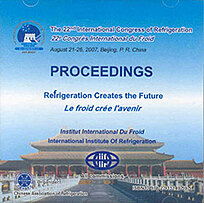
Document IIF
Refroidissement par pulvérisation des composants électroniques.
Spray cooling of electronic components.
Auteurs : KHODABANDEH R., JONSSON F., HAN X., et al.
Résumé
To provide reliable cooling with a package power density in the order of 100 W/cm2 and more it is necessary to use liquid cooling due to the limit of air-cooling. Spray cooling with phase change has been considered in industrial applications due to its extremely high heat removal capability at low wall superheat. Spray cooling can be achieved by spraying a heated surface with a liquid that is subcooled or is at saturation temperature. The testing system consists of a spray nozzle, heated surface, a test chamber, a condenser, connecting tubes and a pump. In the test chamber the fluid is sprayed at the heated surface causing it to evaporate. The vapour flows to the condenser, reject its heat there and the liquid is pumped again to the spray nozzle. A variable speed pump is used for circulation of the refrigerant. Volume flow rate is measured at various pump speeds, meanwhile, the saturation temperature, pressure before and after the pump and the temperatures at the corners and the middle of the 12.6 x 12.6 mm copper heater are measured. The pump has a maximum flow rate of 500 ml/min. It can work at max system pressure of 20 bar and max differential pressure 5.5 bars. The nozzle used for the test rig was from Spraying Systems Company and labelled 1/4 T-SS and TG-SS 0.5. FC-72, FC-87 and R-245fa are used as refrigerants.
Documents disponibles
Format PDF
Pages : ICR07-B1-1391
Disponible
Prix public
20 €
Prix membre*
Gratuit
* meilleur tarif applicable selon le type d'adhésion (voir le détail des avantages des adhésions individuelles et collectives)
Détails
- Titre original : Spray cooling of electronic components.
- Identifiant de la fiche : 2008-0397
- Langues : Anglais
- Source : ICR 2007. Refrigeration Creates the Future. Proceedings of the 22nd IIR International Congress of Refrigeration.
- Date d'édition : 21/07/2007
Liens
Voir d'autres communications du même compte rendu (839)
Voir le compte rendu de la conférence
Indexation
- Thèmes : HFC
- Mots-clés : Aspersion; R245fa; Électronique; Refroidissement; Experimentation; Frigorigène; Composant
-
Flow boiling heat transfer in microchannel cold...
- Auteurs : BERTSCH S. S., GROLL E. A., GARIMELLA S. V.
- Date : 14/07/2008
- Langues : Anglais
- Source : 2008 Purdue Conferences. 19th International Compressor Engineering Conference at Purdue & 12th International Refrigeration and Air-Conditioning Conference at Purdue [CD-ROM].
- Formats : PDF
Voir la fiche
-
Experimental investigation on R245fa throttling...
- Auteurs : HUANG M., LIANG X., WU Y., et al.
- Date : 09/07/2018
- Langues : Anglais
- Source : 2018 Purdue Conferences. 17th International Refrigeration and Air-Conditioning Conference at Purdue.
- Formats : PDF
Voir la fiche
-
Application of scaling principles for predictio...
- Auteurs : ZHELEZNY V., SEMENYUK Y. V., LOZOVSKY T., et al.
- Date : 21/08/2011
- Langues : Anglais
- Source : Proceedings of the 23rd IIR International Congress of Refrigeration: Prague, Czech Republic, August 21-26, 2011. Overarching theme: Refrigeration for Sustainable Development.
- Formats : PDF
Voir la fiche
-
Status and challenges in thermal design of elec...
- Auteurs : LASANCE C. J. M.
- Date : 24/10/1997
- Langues : Anglais
- Source : Thermal management of electronic systems III. Proceedings of the EUROTHERM Seminar 58.
Voir la fiche
-
Centrifugal compressor performance deviations w...
- Auteurs : WU Y., THILGES C.
- Date : 14/07/2014
- Langues : Anglais
- Source : 2014 Purdue Conferences. 22nd International Compressor Engineering Conference at Purdue.
- Formats : PDF
Voir la fiche
